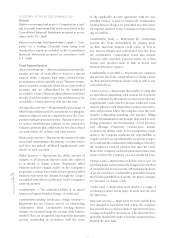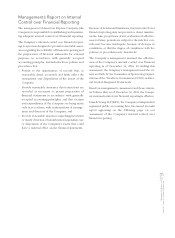American Express 2004 Annual Report Download - page 72
Download and view the complete annual report
Please find page 72 of the 2004 American Express annual report below. You can navigate through the pages in the report by either clicking on the pages listed below, or by using the keyword search tool below to find specific information within the annual report.
performance of the CDOs’ collateral. AEFA’s invest-
ment in CDOs are backed by high-yield bonds and/or
bank loans and are considered to be illiquid. Some of
AEFA’s holdings in these structured investments were
required as a condition for managing them.
Deferred annuities inforce — Represents the amount
of deferred annuities currently inforce from annuities
sold. Generally, the higher the number of policies in
force, the higher the amount of revenues recognized.
Distribution fees — Primarily represent point-of-sale
fees (i.e., front-load mutual fund fees) and asset-based
fees (i.e., 12b-1 fees) derived from the sale of certain
products and fees earned from brokerage-related
activities. These fees are generally based on a contrac-
tual fee as a percentage of assets.
Gross dealer concession sales — a commonly used
financial services industry measure of the sales produc-
tion of the advisor channel.
Investment gains and losses — Primarily represent
gains and losses realized on the sale of investments, but
also include other-than-temporary impairment losses
recognized on Available-for-Sale securities and com-
mercial mortgages as well as adjustments to the carry-
ing value of structured investments.
Investment management and service fees — Fees earned
by the Company on assets that AEFA manages for custom-
ers. These assets primarily relate to managed assets
for proprietary mutual funds, proprietary account assets
and non-proprietary assets held within wrap accounts.
Management fees are primarily based upon the level
of assets under management by AEFA and are generally
collected on a monthly basis. These fees include fees
for services such as research, portfolio management,
technology and related administrative services.
Life insurance inforce — Represents the amount of life
insurance currently inforce from life insurance policies
issued. Generally, the higher the number of policies
inforce, the higher the amount of revenues recognized.
Managed assets — Represents assets managed by AEFA
which are beneficially owned by clients and includes
both proprietary and non-proprietary assets, substan-
tially retail mutual funds managed for individuals. AEFA
receives a fee based on the value of the assets. These
assets are not reported on the Company’s Consolidated
Balance Sheet.
Non-proprietary funds — A broad selection of third-
party funds sold through AEFA’s advisor network.
Owned assets — Represent assets for which the Com-
pany bears all risks and rewards associated with own-
ership and are reported in the Company’s Consolidated
Balance Sheet. Owned assets consist principally of the
fair value of Available-for-Sale and trading investment
securities, as well as the net amortized cost of invest-
ment loans. Separate account assets are also included
in owned assets. See definition of separate accounts for
further discussion.
Proprietary funds — Represent mutual funds that the
Company establishes, markets and manages on behalf
of its clients.
Sales inducement costs — Primarily consist of bonus
interest credits and premium credits added to certain
annuity contract values. These benefits are capitalized
to the extent they are incremental to amounts that
would be credited on similar contracts without the
applicable feature. Prior to the adoption of SOP 03-1,
these costs had been previously included in DAC.
Secured loan trusts — A structured investment wherein
AEFA retains an interest (as a noteholder) whose return
is based on a reference portfolio of loans. The SLT is
generally structured such that the principal amount of
the loans in the reference portfolio is a multiple of the
par value of the notes held by AEFA. The investment
is considered to be illiquid and AEFA’s return is based
on the performance of the underlying loans.
Separate accounts — Represent assets and liabilities
that are maintained and established primarily for the
purpose of funding variable annuity and insurance
products. The assets of the separate account are only
available to fund the liabilities of the variable annuity
contract holders and others with contracts requiring
premiums or other deposits to the separate account.
Clients elect to invest premiums in stock, bond and/or
money market funds depending on their risk tolerance.
All investment performance, net of fees, is passed
through to the client.
Traditional life insurance — Refers to term and whole
life insurance policies that pay a specified sum to a
beneficiary upon death of the insured. These policies
do not subject the contractholder to the investment
risks associated with universal and/or variable life
insurance policies.
Universal life insurance — Universal life insurance is
a form of permanent life insurance that is characterized
by its flexible premiums, its flexible face amounts and
death benefit amounts, and its unbundling of the pric-
ing factors (i.e., mortality, interest and expenses). In
AXP
AR.04
70
Financial Review
























